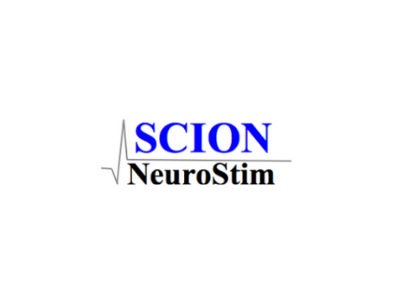更新于:2024-12-20

Scion NeuroStim, Inc.
更新于:2024-12-20
概览
关联
14
项与 Scion NeuroStim, Inc. 相关的临床试验Simple, Home-use Neurostimulation tReatment for Parkinson's Disease dEmeNtia
The purpose of this single arm study is to evaluate the feasibility and safety of treatments with a non-invasive neuromodulation device in adults diagnosed with mild/moderate Parkinson's disease dementia (PDD). A non-invasive device is a device that stays outside of the body and is not implanted and does not penetrate the skin.
Neuromodulation means that the device stimulates activity in the brain.
Neuromodulation means that the device stimulates activity in the brain.
开始日期2024-05-08 |
申办/合作机构 |
WeArable Neuromodulation DeVice for the TrEatment of Alzheimer's Disease
This is a double- blind, randomized controlled trial with an open label extension designed to evaluate the safety and potential efficacy of a non-invasive brainstem neuromodulation device for treating symptoms associated with Alzheimer's disease (AD).
开始日期2023-12-01 |
申办/合作机构 |
The Clinical and Functional Imaging Effects of Non-invasive Neuromodulation on Illness Awareness in Schizophrenia
Our proposed study employs a novel approach to determine the clinical and functional imaging effects of brainstem neuromodulation, with an investigational study device, on illness awareness in schizophrenia - a significant contributor to medication non-adherence and poor treatment outcomes, and arguably the most treatment resistant manifestation of the disorder.
The study device under investigation provides a safe and non-invasive method of brainstem stimulation that will be used in conjunction with a neuroimaging biomarker to measure brain changes associated with treatment and illness awareness.
The study device under investigation provides a safe and non-invasive method of brainstem stimulation that will be used in conjunction with a neuroimaging biomarker to measure brain changes associated with treatment and illness awareness.
开始日期2023-10-03 |
申办/合作机构 |
100 项与 Scion NeuroStim, Inc. 相关的临床结果
登录后查看更多信息
0 项与 Scion NeuroStim, Inc. 相关的专利(医药)
登录后查看更多信息
1
项与 Scion NeuroStim, Inc. 相关的文献(医药)Journal of Personalized Medicine
Vestibular Neurostimulation for Parkinson’s Disease: A Novel Device-Aided Non-Invasive Therapeutic Option
Review
作者: Ade, Kristen ; Ray Chaudhuri, K. ; Podlewska, Aleksandra ; Limbachiya, Naomi ; Qamar, Mubasher ; Poplawska-Domaszewicz, Karolina ; Batzu, Lucia
Dopaminergic replacement therapy remains the mainstay of symptomatic treatment for Parkinson’s disease (PD), but many unmet needs and gaps remain. Device-based treatments or device-aided non-oral therapies are typically used in the advanced stages of PD, ranging from stereotactic deep brain stimulation to levodopa or apomorphine infusion therapies. But there are concerns associated with these late-stage therapies due to a number of procedural, hardware, or long-term treatment-related side effects of these treatments, and their limited nonmotor benefit in PD. Therefore, there is an urgent unmet need for low-risk adjuvants or standalone therapies which can address the range of burdensome motor and nonmotor symptoms that occur in PD. Recent studies suggest that non-invasive neurostimulation of the vestibular system may be able to address these gaps through the stimulation of the vestibular brainstem sensory network which extensively innervates brain regions, regulating both motor and a range of nonmotor functions. Therapeutic non-invasive vestibular stimulation is a relatively modern concept that may potentially improve a broad range of motor and nonmotor symptoms of PD, even at early stages of the disease. Here, we review previous studies supporting the therapeutic potential of vestibular stimulation for the treatment of PD and discuss ongoing clinical trials and potential areas for future investigations.
100 项与 Scion NeuroStim, Inc. 相关的药物交易
登录后查看更多信息
100 项与 Scion NeuroStim, Inc. 相关的转化医学
登录后查看更多信息
组织架构
使用我们的机构树数据加速您的研究。
登录
或

管线布局
2024年12月23日管线快照
无数据报导
登录后保持更新
药物交易
使用我们的药物交易数据加速您的研究。
登录
或

转化医学
使用我们的转化医学数据加速您的研究。
登录
或

营收
使用 Synapse 探索超过 36 万个组织的财务状况。
登录
或

科研基金(NIH)
访问超过 200 万项资助和基金信息,以提升您的研究之旅。
登录
或

投资
深入了解从初创企业到成熟企业的最新公司投资动态。
登录
或

融资
发掘融资趋势以验证和推进您的投资机会。
登录
或

标准版
¥16800
元/账号/年
新药情报库 | 省钱又好用!
立即使用
来和芽仔聊天吧
立即开始免费试用!
智慧芽新药情报库是智慧芽专为生命科学人士构建的基于AI的创新药情报平台,助您全方位提升您的研发与决策效率。
立即开始数据试用!
智慧芽新药库数据也通过智慧芽数据服务平台,以API或者数据包形式对外开放,助您更加充分利用智慧芽新药情报信息。
生物序列数据库
生物药研发创新
免费使用
化学结构数据库
小分子化药研发创新
免费使用